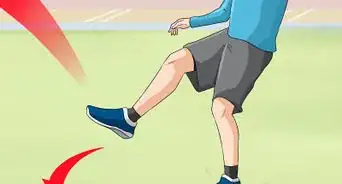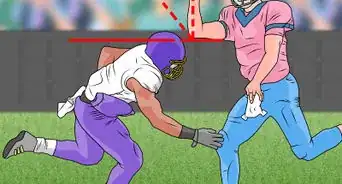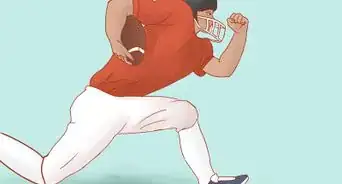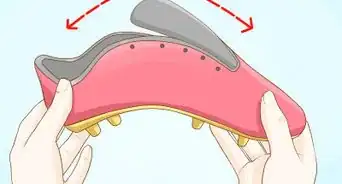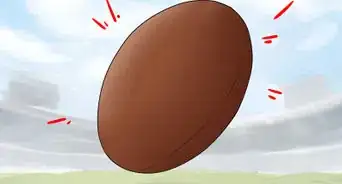wikiHow is a “wiki,” similar to Wikipedia, which means that many of our articles are co-written by multiple authors. To create this article, 73 people, some anonymous, worked to edit and improve it over time.
This article has been viewed 466,475 times.
Learn more...
Oftentimes winning a football game comes down to which team can make the most field goals. The kicker of a football team has a very specialized role to perform which relies almost entirely on technique. Mastering the art of field goal kicking takes time, patience, and hours of hard work, but you can learn the basic technique by following the steps below. Remember, practice makes perfect, and if you dedicate your sweat to learning to kick a field goal, you'll be sending footballs through the goal posts in no time.
Steps
Setting Up the Field Goal Kick
-
1Learn the basic rules of a field goal kick. In the National Football League (NFL), any field goal attempted and missed from beyond the 20-yard line causes the defensive team to take possession of the ball where the kick was missed. Any field goal attempted and missed from on or inside the 20-yard line causes the defensive team to gain possession of the ball on the 20-yard line.
- The football must pass between the goal posts in order for a field goal to count. It is allowed to hit the side of the goal posts first as long as the football goes through afterward.
- A field goal is worth three points and is usually run on a fourth down when a team is within reasonable distance of their opponent's end zone.
-
2Set up the football. Place the football perpendicular to the ground on the holder. The football should be mostly upright with a slight slant toward the holder.
- Line up the laces so that they are facing the field goal. Doing so prevents the laces from interfering with the direction of the ball.
- This also allows you to kick the ball on the back seams, the spot which creates maximum compression when kicked. Maximum compression ensures that the football will travel farther and higher.
Advertisement -
3Walk backward away from the ball the number of paces appropriate for you. While there is no concrete number of paces that you must step back, for most is it about three large paces back and two paces to the left of the ball for right-footed kickers.[1]
- For left-footed kickers, take three paces back and two to the right of the ball.
- Try out different distances to see what works best for you. The length of your legs will have an impact on how far you step back. The longer your legs, the longer your stride will be when you run to kick the ball.
- The important thing to remember when stepping back is to be consistent. Find a distance that works for you and practice it consistently.
-
4Position yourself in an athletic stance. An athletic stance means that your knees are slightly bent, you are resting on the balls of your feet, and your body weight is centered over your hips.
- Place the foot that you will not use to kick the ball slightly in front of your kicking foot. This foot is called your plant foot because you will plant it next to the ball while kicking.
- Place your kicking foot slightly behind your plant foot. The toes of both feet should be pointing toward the places they will be upon contact.
-
5Take your approach steps. Calculating the correct number of approach steps is one of the trickiest parts of kicking a field goal. Usually, kickers take about two to three approach steps. Approach steps are executed at a relatively slow pace and in three steps:[2]
- The first step is optional and is called a jab step. This step will be a short step in the direction of the ball with your plant foot. Its purpose is to shift your body weight forward in the direction of the ball.
- The second step is called the drive step and is executed by taking a long stride in the direction of the ball with your kicking foot.
- The third step is taken by your plant foot to the side of the football. This is the most important step as it determines where your plant foot will anchor you to the field while you kick the ball.
- Because you are lined up behind and to the side of the football, you will be approaching the ball in a diagonal line.
-
6Position your plant foot so that it points towards the football. Your target is the area of the field goal that you want the football to go through. Your plant foot should be about five to seven inches behind your target.[3]
- The depth of your plant foot will vary depending on the height of the ball. If you are kicking on the ground your plant foot will be about four inches deeper than the football.
- If you are using a one-inch tee, your plant foot will be about two inches deeper than the football, and if your tee is about two inches high, your plant foot will be about equal with the football.
-
7Keep your hips and shoulders in line. When you approach the football, be sure to have your torso square. This will help you achieve a steady balance while kicking.
Mastering the Kick
-
1Make contact with the ball. Aim for the "sweet spot," about 4 inches (10.2 cm) above the bottom tip of the football. Where you make contact with the ball is important because it allows you to manipulate the distance and height that the football will travel.
-
2Kick the ball with the top of your foot. By using the bone on the top of your foot, you are able to produce the maximum transfer of energy to the ball.
- There are two types of kicking, straight and soccer-style. Almost all professional football players use the soccer-style kick.
- A straight kick simply means that after you make contact with the ball, your leg follows through in a straight line perpendicular to the ground. Straight-on kickers lock their ankles while kicking, allowing them to efficiently transfer kinetic energy forward.
- A soccer kick occurs when you swing your leg through to the opposite side of the ball that you kicked after making contact. Soccer-style kickers angle their foot at an obtuse angle, causing some of energy to be absorbed by the ankle joint. Test out both to see which you prefer, but remember that modern convention points to the soccer kick as the better of the two styles.
-
3Follow the kick through your target. Once you make contact with the football, don't stop the forward motion of your foot. Instead, try to continue the kicking motion until well after the ball has left your foot.[4]
-
4Keep the speed and strength of the kick consistent all the way through. You do not need to change the power you put into your kick much even if you are kicking a long field goal. The power in your kick comes from your plant leg and the momentum of your kicking leg.
-
5After you follow through, hop your plant foot slightly forward. This will occur naturally as a result of the forward momentum of your body and your body's effort to keep you on balance.
Community Q&A
-
QuestionHow do I effectively kick a ball towards the goal from a distance?
 Community AnswerKeeping the toe pointed and follow-through are keys for distance. Do not look up too early, as the jerking of your upper body to see where the ball goes could potentially cause you to kick a bad ball.
Community AnswerKeeping the toe pointed and follow-through are keys for distance. Do not look up too early, as the jerking of your upper body to see where the ball goes could potentially cause you to kick a bad ball. -
QuestionHow many kicks a day should I attempt?
 Community AnswerHow many kicks a day depends on how many you can do. You might start with 10 to 15 a day to see what needs to happen, and to see if you are constant.
Community AnswerHow many kicks a day depends on how many you can do. You might start with 10 to 15 a day to see what needs to happen, and to see if you are constant. -
QuestionCan a field goal be kicked too high to count?
 Community AnswerNo, a field goal counts as long as the ball goes between the poles, even if it is very high.
Community AnswerNo, a field goal counts as long as the ball goes between the poles, even if it is very high.
Warnings
- Don't kick the football with your toes or ankles. Doing so will decrease accuracy and distance when kicking a field goal.⧼thumbs_response⧽
- Taking too many approach steps may result in a blocked kick as it gives the other team more time to react.⧼thumbs_response⧽
- Do not compensate for the wind before 20 yards (18.3 m); the wind will not have much or any effect on the ball before that yardage threshold.⧼thumbs_response⧽
- Do not kick too much, overworking your joints is potentially harmful.⧼thumbs_response⧽
- When you practice, always wear tennis shoes. If you kick a ball with sandals, you may hurt or break your toes.⧼thumbs_response⧽
References
- ↑ http://insidethepylon.com/football-101/football-basics/2015/03/02/basic-placekicking-technique-how-to-kick-field-goals/
- ↑ http://insidethepylon.com/football-101/football-basics/2015/03/02/basic-placekicking-technique-how-to-kick-field-goals/
- ↑ https://www.coachup.com/nation/articles/field-goals
- ↑ https://www.ducksters.com/sports/football/how_to_kick_a_field_goal.php
- https://www.youtube.com/watch?v=7d9eX73CYWs
About This Article
To kick a field goal, start by taking 3 steps back from the ball, then standing with your knees slightly bent and your weight on the balls of your feet. Next, take 2 or 3 steps toward the ball, and on the last step, plant your foot about 5 to 7 inches behind the ball. Then, kick the ball with the top of your other foot for more power and control. After making contact, continue swinging your foot in the direction of the goal and try to keep the speed and strength consistent all the way through. For more tips, including how to set the football on the holder for the best kick, keep reading.
